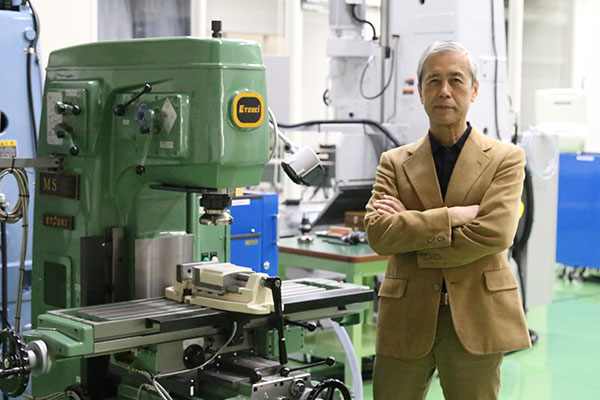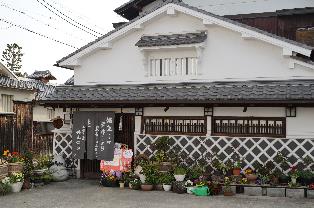
2021年4月2日(金)に、京都亀岡キャンパスのある亀岡市に蔵を構える丹山酒造様で、バイオ環境学部食農学科2年生と3年生の有志が酒造り体験をしました。
本学バイオ環境学部では、学生実習として耕作放棄地を再整備した「復活水田」で稲の栽培を行っています。そこで獲れたお米を原料に、丹山酒造様と連携し、「大槻並」や「霧美命」といった大学オリジナルブランドの日本酒を開発してきました。
現在、丹山酒造様では、2020年秋に復活水田で収穫したお米を原料に日本酒の醸造を進めていますが、その作業の一部を体験させていただきました。
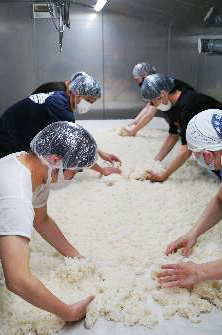
まずは、蒸したお米をタンクに運ぶ作業にとりかかりました。蒸したお米は、思いのほか硬く、また重たく、スコップでかきだすのに苦労しました。つぎは、タンクに入れたお米を「櫂」で混ぜる作業「櫂入れ」です。ここで、お米(掛米)が酵母の入った酒母や米麹と一緒になり、発酵が進みます。蔵人の方は、軽々櫂を操っていましたが、学生の手ではなかなか思うように動きません。酒造りの大変さを、文字通り身をもって知りました。また、0.1℃単位での温度調整や高さ1mm単位での容量調整などが行われており、品質管理の厳密さを目の当たりにしました。
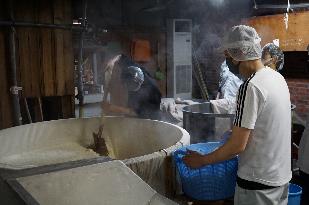
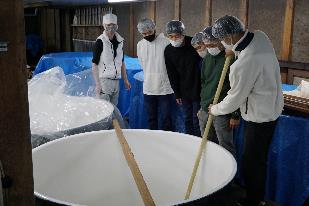
続いて、米麹を作る暖かな部屋、「麹室(こうじむろ)」に移動しました。通常、外部の者は立ち入れないところですが、今期最後の作業とのことで、特別に入れていただきました。ここでは、「種切り」を行いました、麹菌を蒸したお米に振りかける作業です。麹菌の入った容器を振ると、胞子がゆっくりと舞い落ちていきました。しばらくの間息をひそめ、胞子が落ち着くのを待って、米を混ぜ、また振りかけ、最後はお米を中央に集め、布団をかぶせました。こうして菌を繁殖させるのです。
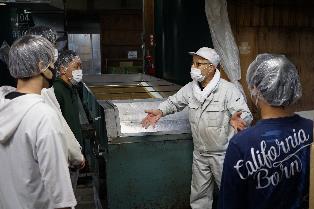
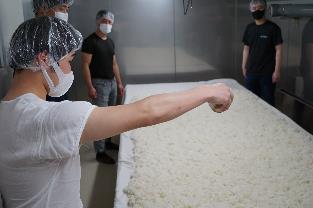
最後に明日仕込むお米の洗米作業を見学しました。お米が水を吸収しすぎると、お酒の品質が劣化してしまうので、秒単位で洗米時間が管理されていることを知りました。そのほか、実際に使われている酵母や麹菌の入手方法、大規模な蔵元と小規模な蔵元の違い、杜氏になるまでの道のりなど、醸造現場ならではのお話もたくさん伺えました。また、若い蔵人の皆様がいきいきと働いている姿をみて、大いに刺激を受けました。
酒造工程や関連するお話をわかりやすく、かつ、おもしろくご説明くださった杜氏の栗山様はじめ、個々の作業をやさしく丁寧にご指導くださった丹山酒造の皆様に心より感謝申し上げます。
(バイオ環境学部 船附秀行)
[Faculty of Bioenvironmental Sciences News] Second and third-year students from the Department of Agriculture and Food Technology had a sake brewing experience.
On Friday, April 2, 2021, second and third-year students from the Department of Agriculture and Food Technology, Faculty of Bioenvironmental Sciences, had the opportunity to experience sake brewing at the Tanzan Sake Brewery in Kameoka City, where the Kyoto Kameoka Campus is located.
The Faculty of Bioenvironmental Sciences at KUAS has been cultivating rice in restored paddy fields, which were reclaimed from abandoned farmland, as part of student training. Using the rice harvested there as a raw material, we have been working with Tanzan Sake Brewery to develop the university’s original brands of sake, "Otsukunami" and "Kiribisho.".
Currently, the Tanzan Sake Brewery is brewing sake using rice harvested in the fall of 2020 from the restored paddy fields, and we were able to experience a part of that process.
The first step was to carry the steamed rice to the tank. The steamed rice was harder and heavier than expected, so we had a hard time scooping it out with a shovel. The next step was to use an oar-like stirring tool (‘kai’) to mix the rice in the tank. At this point, the rice (‘kakemai’) is combined with yeast mash and malted rice, and fermentation progresses. The brewer (‘kurabito’) handled the kai with ease, but it was difficult for the students to move it the way they wanted. We learned firsthand, literally, how hard it is to brew sake. We also witnessed the strict quality control as the temperature was adjusted in increments of 0.1°C and the volume was adjusted in increments of 1mm in height.
Next, we moved to the kojimuro, a warm room where malted rice is made. Normally, only staff are allowed to enter this room, but as it was the last work of this season, we were allowed in as a special exception. Here, we did tane kiri, which is the process of sprinkling koji mold (Aspergillus oryzae) onto the steamed rice. When we shook the container with the koji mold in it, spores slowly fluttered down from the container. We held our breath and waited for the spores to settle down, then we mixed it with the rice, sprinkled a bit more, and finally gathered the rice in the center and covered it with a futon. This process is what allows the fungus to multiply.
Finally, we observed the washing of the rice that would be prepared the following day. We found out that the washing time of rice is controlled down to the second because if the rice absorbs too much water, the quality of the sake will deteriorate, so. In addition, we heard many unique stories about what is like to work at brewery, such as how to obtain the yeast and koji mold that are actually used in the brewing process, the differences between large and small breweries, and how to become a chief brewer (‘toji’) at a sake brewery. It was also very inspiring to see the energetic and lively way that the young brewers were working.
I would like to express my heartfelt gratitude to Mr. Kuriyama, the chief brewer, who explained the brewing process and related topics in a way that was easy-to-understand and interesting, and also to everyone at Tanzan Sake Brewery, who kindly and carefully guided us through each individual task in the brewing process.
(Professor Hideyuki Funatsuki, Faculty of Bioenvironmental Sciences)
- 対象者
- 学部・学科
- 内容


